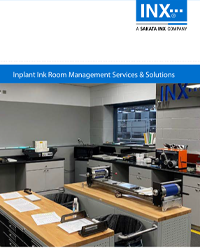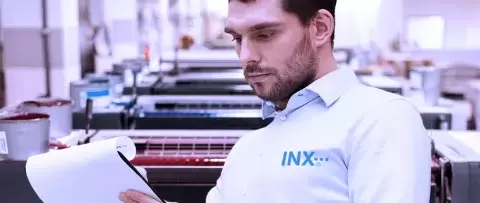How to Conduct a Total Cost Analysis for Ink
Understanding the obvious and the unknown costs of ink
How much does your ink cost? Ink ‘price’ and ink ‘cost’ are two different, yet important points to consider when conducting a total cost analysis of your ink. Customers have realized many advantages to understanding the total cost of ink, including: reduced down-time, increased color quality, and improved throughput. This blog post provides an overview of the inputs to include, typical KPI’s, and the benefits of ink dispensers to help you conduct a total cost analysis of the ink you are using.
Total Ink Cost Inputs
There are a number of different variables that may affect ink costs on any given job. Probably the most obvious input to include is price. Yet, the price of ink and the total cost of ink are two distinctive inputs. The price of ‘ink A’ may be higher than the price of ‘ink B,’ but the cost of running ink A may be significantly lower in cost.
When conducting a total cost analysis, we create or select a discrete job on a specific substrate and formulate the exact amount of ink assigned to that job. We then calculate how much ink was used per unit (sheets, footage, impressions, etc.). That is just our starting point. In order to determine the true cost of ink, other variables beyond price and cost per sheet are considered, including:
- Color Match Time: The cost of lost production time because of color complications and/or extensive time needed for color matching. Read Best Practices for Color Management in the Pressroom
- Substrate and Ink Waste: The cost of substrate material scrapped because of production errors and/or damage as well as the cost of any unused ink that is relegated to waste.
- Ink Mileage: The cost of having to use more ink on the substrate than necessary to achieve the exact color specified. Ink mileage can be negatively impacted because of problems with pH, viscosity, color strength, dilution ratio, substrate absorption, etc.
- Press Down-Time: The cost of lost production time due to a variety of issues, such as failures/remakes, color matching, dirty print, and/or inks not press-ready, etc.
Although the above-mentioned are the most common inputs comprising a total cost analysis of ink, there are other less-noticeable costs. For example, transportation costs to ship the ink from the manufacturer to the converter and/or printer; personnel costs to assure color quality; the quality and maintenance of the machine being used; and, costs incurred to monitor and control ink-related processes and problems.
Total Ink Cost KPIs
Just as there are common inputs used when conducting a total cost analysis, there are also customary key performance indicators (KPIs). At INX, we commonly provide customers with throughput and waste metrics. Throughput is measured by:
- Average press speed
- Net feet/minute
- Net feet/hour
- Net feet/day
- Uptime percentage over a 24-hour period
The percentage of waste is calculated by reviewing:
- Overall print quality
- Defects
- Downtime required to clean plates
- The time needed to achieve the required color match
The below is an example of a total cost analysis for one of our customers that incorporates several of the above-mentioned KPIs.
| Throughput Measured By: | Incumbent | INX | Difference |
|---|---|---|---|
| Net feet / hour | 63,000 | 102,000 | 39,999 |
|
Time to complete |
31.7 hours |
19.6 hours |
12.1 hours |
|
Machine rate cost / 2M feet |
$25,260 |
$15,680 |
$9,680 |
| Substrate Waste Contributors Measured By: | Incumbent | INX | Difference |
|---|---|---|---|
| % Total waste | 5.10% | 1.20% | 3.90% |
|
Total waste in lbs. |
2242 lbs. | 528 lbs. | 1714 lbs. |
| Substrate cost / lb. - $1.04 | $2,332 | $549 | $1,783 |
Helpful Resources
Conducting a total cost analysis of your ink can be difficult if you do not have access to the level of detail and tracking information required for a thorough and accurate evaluation. INX International offers customers a variety of advanced dispensing systems that provide convenience and an additional level of operational information. Dispensing programs make it easier to determine the total cost of ink and also contribute to reducing costs by dispensing only enough ink needed for the job which helps to eliminate any excess return and left-over ink.

- AccuBlend-HV™ from GFI (PDF): Dispenses just-in-time color, in just the right amount, just steps away from your press. AccuBlend-HV models produce spot colors for conventional offset, UV offset, dry offset, metal decorating and other highly viscous paste type inks. A hybrid model is also available for UV flexo spot color needs.
- HMJ TECH HMJ-A200: HMJ tech’s A200 is a compact industrial-grade dispenser. Despite its size and affordable price tag, the A200 has a ton of big-machine features including fully-automated cleaning and single-point dispense. It is designed to accommodate up to 14 ingredients. It uses a 2-range+pulse valve with clean, laminar flow and predictable dispenses every time!
- HMJ TECH HMJ-A255: The A255 can accommodate up to 24 ingredients and can be configured with any combination of pails, drums or totes. HMJ techs large port 2-stage dispense valves are used. A 40-pound (20kg) batch of ink can be made in 3 ½ minutes to a precision of 0.0004 pounds (0.2 grams.
- HMJ TECH HMJ-A300: The A300 is HMJ tech’s high performance pail dispensing system. It utilizes HMJ techs 3-stage dispense valves. The average batch time for a 40-pound batch (20kg) is 2 minutes. The system can be configured with as many as 32 ingredients.
- HMJ TECH HMJ-355: The A355 is designed to manufacture batches up to 300kgs using a dual scale configuration (pail and drum). The dual scale configuration ensures the highest possible dispense accuracy for any batch size. This system is designed for larger operations with exceptionally high output requirements. It can accommodate up to 28 ingredients.
- NOVAFLOW N50: The Novaflow N50 is designed for solvent laden, class 1, division 1, explosive environments and uses a two-stage dispense valve, allowing the user to choose accuracy or speed. Multiple batch sizes between 5 and 55 gallons can be handled with standard scales. Larger batch containers can be accommodated on a custom basis. Raw materials can be pumped from buckets, drums, or bulk containers.
- NOVAFLOW N20W: The NovaFlow N20 uses a two stage dispense valve, allowing the user to choose accuracy or speed. Multiple batch sizes can be handled with the standard scales. One-gallon batches can be produced with the automatic scale indexing option. Raw materials can be pumped from buckets, drums, or bulk containers.
Conclusion
Many converters and printers may see ink as just a small piece of their total cost of goods sold (COGS). Unfortunately, this approach can leave a lot of money on the table. As with most decisions, the total cost of ink has obvious, visible costs as well as those somewhat hidden costs. All relevant cost inputs should be evaluated to ensure the best option for your business is selected. As the third largest provider of INK in the world, we help customers accurately measure the total cost of ink and identify opportunities for improvement and potential for increasing profitability.
DOWNLOAD
Ink room management solutions that increase your efficiencies and reduce cost
Download Brochure















